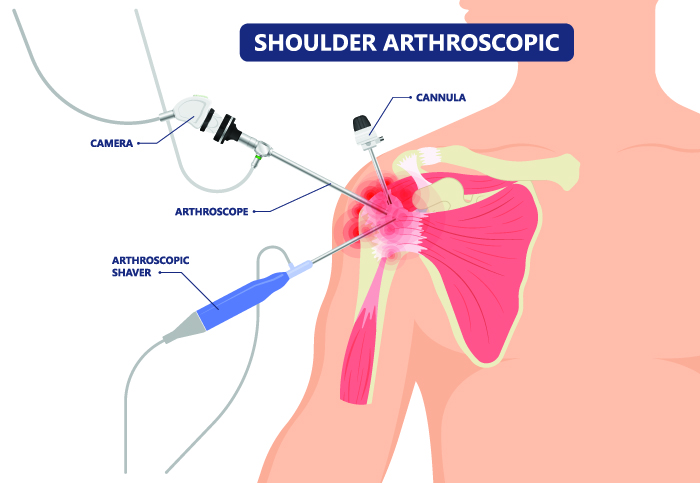Shoulder Arthroscopy Surgery in C-scheme, Jaipur
The shoulder is a complicated joint that has many moving parts. It can be difficult to diagnose and treat, but it doesn’t have to be. Shoulder Arthroscopy is a minimally invasive procedure that allows the surgeon to examine and treat the shoulder joint without making large incisions. It can be used for the diagnosis or treatment of various conditions such as rotator cuff tears, labral tears, bursitis, tendonitis and impingement syndrome.
What is Shoulder Arthroscopy?
This type of arthroscopy has many benefits including less risk of infection and quicker recovery time than traditional open procedures. There are also no sutures needed after this procedure which means there is less chance for scarring or infection at the site where sutures were placed. The procedure is performed under local anaesthesia with sedation so there is minimal discomfort afterwards.

Indications that you need Shoulder Arthroscopy
If the non-surgical treatments have failed and you’ve been experiencing any of the following symptoms, it may indicate that you need to get a Shoulder Arthroscopy done.
- Pain in the front or back of the shoulder
- A feeling that there is something stuck in your shoulder joint.
- Rotator cuff tears
- Labral tears
- Bursitis
- Arthritis in the shoulder joint
- Impingement syndrome
- Instability of the shoulder joint
What happens during Shoulder Arthroscopy surgery?
During the surgery at Apollo Spectra, Jaipur, the surgeon makes a small incision near the top of the patient’s arm, inserts an arthroscope into the joint, and then uses instruments inserted through other small incisions to examine and repair any damage found inside. Once the entire procedure is completed, the doctor will close the incision with staples or stitches and cover it with bandages.
How the patient is positioned during Shoulder Arthroscopy surgery?
Positioning facilitates exposure of anterior structures such as the biceps tendon, coracoid process, acromion process and clavicle. It also permits visualization of posterior structures such as the humeral head and glenoid fossa which are not easily seen from other positions. The positioning technique can be modified according to surgeon preference or anatomical variation in patients’ anatomy.
Prone Position- In the Prone position, the patient lies face down on an operating table with arms at their sides. This position accesses anterior or posterior structures of the shoulder joint.
Supine Position- In the Supine position, the patient lies face up on an operating table with arms over their head and hands clasped behind their neck. This position accesses lateral structures of the shoulder joint such as rotator cuff tendons and biceps tendon sheath.
How to get prepared for Shoulder Arthroscopy at Apollo Spectra, Jaipur?
Firstly, you should stop eating or drinking anything for 8 hours before going under anaesthesia. Stop taking any blood thinners like aspirin, ibuprofen, naproxen or warfarin. If you have diabetes, talk with your doctor about how best to manage your blood sugar levels before and after surgery so there's less risk of complications from low blood sugar levels post-surgery. It’s important to mention any allergies or other medical conditions such as heart disease, high cholesterol, osteoporosis or asthma so that doctor can take special care of these issues while preparing for your procedure.
Request an appointment at Apollo Spectra Hospitals, Jaipur
Call 1860 500 2244 to book an appointment.
Risks associated
The risks associated with this surgery are minimal but can include few complications.
- Infection at the site of incision
- Bleeding from torn blood vessels in the armpit area
- Damage to nerves or tendons around the shoulder joint
- Blood clots in your arm or lungs
- Dislocation of your joint
The Bottom Line
In Shoulder Arthroscopy, an orthopaedic surgeon makes small incisions in the shoulder. It may take up to 6 weeks or more to fully recover from pain. However, unlike traditional open surgeries, it has a fast recovery time.
The patient may experience some discomfort and pain. This is because of the pressure on nerves in the shoulder area, as well as from any manipulation of tissues or joints. Pain medication can be given to help manage these symptoms.
Arthroscopic surgery is a minimally invasive procedure that uses an arthroscope, which is inserted into the joint through small incisions. The surgeon can see the inside of your joint on a video monitor during the operation. This type of surgery does not require large incisions and typically has less pain after surgery than open surgery. Open Surgery is when surgeons make larger cuts in your skin to operate on your joints. It may be necessary for some types of injuries or if there are other health problems like arthritis or diabetes present in addition to the injury.
Recovery from this surgery can take up to 6 weeks. You should follow these steps for recovery after Shoulder Arthroscopy. Keep your arm elevated above heart level as much as possible during waking hours. Apply ice packs wrapped in cloths to reduce swelling and pain. Do not drive until cleared by your physician. Avoid lifting heavy objects that will put pressure on your shoulder area until healed enough to do so without discomfort or pain.
Symptoms
Our Top Specialities
NOTICE BOARD
CONTACT US
CONTACT US
 Book Appointment
Book Appointment


.svg)
.svg)
.svg)
.svg)








